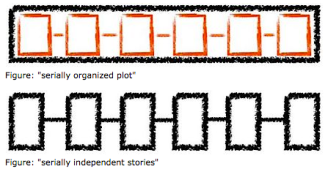
American Horror Story is described as a anthology series that pivots around a completely different set of characters, storyline and location each season, including a house with a murderous past, an insane asylum, a witch coven, a freak show and the latest on-going Season 5 is Hotel (IMDb, n.d.). The show is a complex narrative as it does not have plot closure within every episode that a conventional episodic form would have. Narrative Complexity is the “generation & maintenance of multiple, ongoing, interconnected narratives” (Reyes, n.d.), which is perfectly exemplified not only across the 5 seasons, but also within each season, where there are multiple story lines ongoing, although there are key characters driving the story’s narrative. It is important to understand each subplot in order for character progression and to understand the main plot. Below is a figure illustrating the serially organised plots within the main plot (JN and MS, 2013) :
Much like True Detective that was analysed in lecture, American Horror Story plays on the chronology of the narrative with flashbacks. I will be using the first episode titled ‘No-Tell Hotel ‘of American Horror Story Season 5 Hotel to analyse the devices of a complex narrative and the serial narrative style. Much happens in this almost hour-long season premiere, and as with other anthologies, the same set of actors(with the unfortunate exclusion of Jessica Lange) play different characters.
Link to episode : http://tenplay.com.au/channel-eleven/american-horror-story/season-5/episode-1 (Season 5, Episode 1, 2015)
This season is centered around the devious and supernatural happenings in Hotel Cortez, with key characters such as Detective Lowe, Sally; a junkie who lives in the hotel, Iris the hotel manager, Donovan; Iris’s son and lover of The Countess Elizabeth; who is a wealthy social doyenne and hotel owner.Another feature of a complex narrative is using flashbacks to reveal key aspects of a character’s history “rather than creating deep mysterious for viewers to attempt to piece together” (Mittell, 2012), as this may be confusing for viewers because of the multiple sub plots. The first flashback happens quite late into the episode at 43:19min, which is the backstory of how Detective Lowe’s son went missing in 2010. There is only a title card to establish the flashbacks, with the year and location, and none when it goes back to present-day. The same thing happens at the 50:22min flashback to 1994 for the backstory of Sally and Donovan, and casually slips back to present-day Detective Lowe at 55:01min packing up for his stay at Hotel Cortez.
The show also falls under the serial narrative style as there are a multiplicity of characters involved in simultaneous story lines, where there is an intricate narrative web connecting the main characters (Donnar, 2015). From episode one itself, we learn of the family problems Detective Lowe has since his son went missing, we see a string of connected murders that he is trying to solve, we understand the supernatural happenings in Hotel Cortez, we see the backstory of Sally, Iris and Donovan and the reason why they have been stuck in the hotel, and we get an insight of Donovan and The Countess Elizabeth’s bloody escapades. From this episode alone, my housemate and I were speculating that they could perhaps be vampires from the signs we picked up. We initially guessed that they were spirits unable to move on from the haunted hotel, but this was not the case for these 2 main characters. There are however spirits as well such as the cleaning lady in this episode. Thus, a serial narrative style that American Horror Story follows requires more attentive audience members to work harder to understand the complex narrative and forces the audience to be open to different perspectives to have multiple interpretations of the events (Donnar, 2015)
As with Twin Peaks mentioned in Lecture 6, and True Detective mentioned in Lecture 8, this episode (and all other episodes) in American Horror Story lacks a sense of resolution at the end as the series “is a cumulative narrative that builds over timer, rather than resetting back to a steady-state equilibrium at the end of every episode” (Mittell, 2012 p18). While it may be alright for a viewer not to watch previous seasons / not watch the seasons accordingly since the show is an anthology series, it is vital to watch and pay attention to each episode of the season one is watching in order to fully see character development and also to understand the complex and serial narrative.
References
American Horror Story Wiki, (2015). Hotel (story). [online] Available at: http://americanhorrorstory.wikia.com/wiki/Category:Hotel_(story) [Accessed 27 Oct. 2015].
Donnar, G. (2015). Lecture 6 Audiences and Matters of Taste.
Donnar, G. (2015). Lecture 8 The poetics of complex narrative.
IMDb, (n.d.). American Horror Story (TV Series 2011– ). [online] Available at: http://www.imdb.com/title/tt1844624/ [Accessed 27 Oct. 2015].
JN, and MS, (2013). “serially organized plot” and “serially independent stories”. [image] Available at: http://www.uni-saarland.de/lehrstuhl/solte-gresser/aktuell/serial-narration/handbook/living-handbook/serial-narration/serial-narration-in-literature.html [Accessed 27 Oct. 2015].
Mittell, J. (2012). Complexity in Context. [online] Complex TV. Available at: http://mcpress.media-commons.org/complextelevision/complexity/ [Accessed 27 Oct. 2015].
Reyes, R. (n.d.). R. Salvador Reyes | Narrative Complexity. [online] Rsalvador.com. Available at: http://rsalvador.com/WhatIsNC.html [Accessed 27 Oct. 2015].
Season 5, Episode 1. (2015). Available at: http://tenplay.com.au/channel-eleven/american-horror-story/season-5/episode-1 [Accessed 27 Oct. 2015].